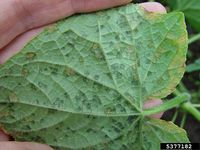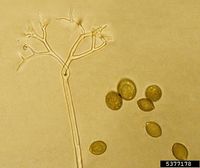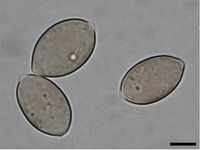Pseudoperonospora cubensis
| Literature database |
|---|
| 184 articles sorted by: |
| • year (descending) |
| • research topics |
| • countries/regions |
| • host plants |
| • list of antagonists |

Author(s): David B. Langston, University of Georgia, United States
Source: Wikimedia Commons
Pseudoperonospora cubensis (Berk. & M.A. Curtis) Rostovzev 1903 - (cucurbit downy mildew)
The oomycete is widespread in temperate regions and economically important on cucurbits (Cucurbitaceae), especially under humid conditions. Important hosts are cucumber, melon, watermelon and squash. The disease results in stunting, wilting and yield reduction. Epidemics can result in 100% yield losses.
Symptoms vary according to the host. On cucumber, squash and pumpkin the oomycete causes angular chlorotic lesions on the foliage, 1-2 weeks after the infection. On the underside of the leaf, grey-brown to purple mycelium masses develop.
| Vernacular names | |
|---|---|
| • Deutsch: | Falscher Gurkenmehltau |
| • English: | cucurbit downy mildew downy mildew of cucurbits |
| • Français: | mildiou des cucurbitacées |
The sporangia disperse via wind or through rain splashes. Between seasons the disease persists on wild hosts, but it does not survive in areas with extended frost periods. The disease is mainly managed by using resistant cultivars and fungicides. In greehouses, environmental control (adjusting the temperature and humidity) is also effective.
The branched sporangiophores bear lemon-shaped sporangia, around 25 x 15 µm large. Each sporangium releases around 10 biflagellate zoospores. Sexual reproduction and the formation of oospores has been rarely observed.
For a reviews see Holmes et al. (2015) and Ojiambo et al. (2015).
- Other images of Pseudoperonospora cubensis (IPM Images, Wikimedia Commons and PaDIL - click to enlarge)




